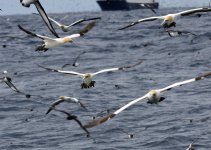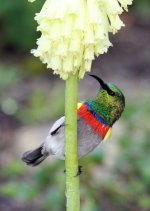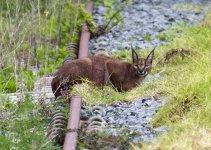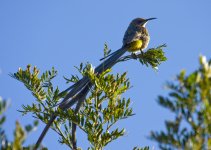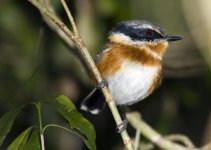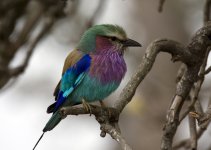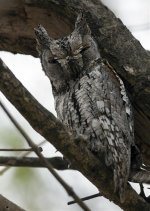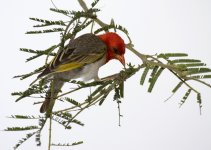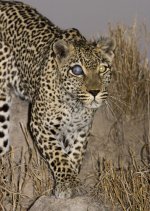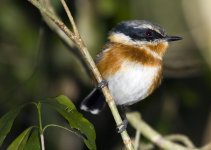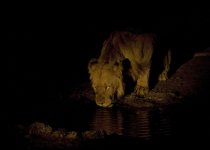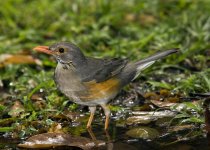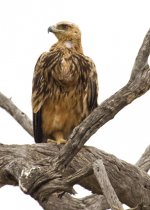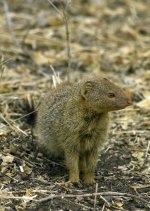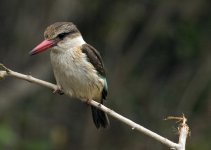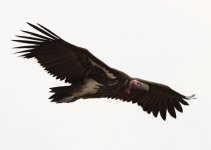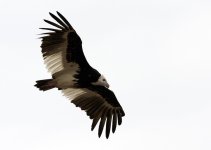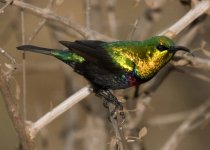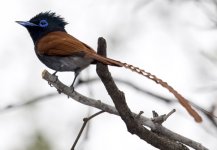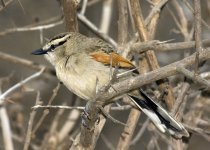Nick Brooks
Well-known member
The following is a rather long trip report from a three week holiday in South Africa last month taking in West Coast, Table Mountain, Wilderness, Tsitsikamma and Kruger National Parks.
To start with a logistics summary, we flew from London to Cape Town overnight. We woke up as we approached Cape Town and, with only an hour’s time difference, had no problems with jet lag. We hired a car and, after two weeks, ended up in Port Elizabeth from where we flew, via Johannesberg, to Hoedspruit; an hour’s drive outside of Kruger. We flew back to London from Hoedspruit, again via Johannesburg.
Travel was very easy and even most dirt roads were pretty flat. Accommodation was mostly in various guesthouses/hotels, which were very comfortable and priced far below UK equivalent accommodation. The missus likes her comforts so we probably spent more than we needed but I reckon you could easily have got good accommodation for £40 or less, per room, per night. Restaurant and café food was excellent and unbelievably low priced compared to the UK.
To get the missus on a safari we were forced to stay in a couple of game lodges, which cost as much for one night as I spent for four nights on National Park accommodation and food in Kruger, after she had gone home. However, the lodges were excellent, the food was great and the service, as with most of SA, was excellent. Furthermore, sitting in an open jeep a couple of yards away from lions and leopards is certainly an experience we’ll never forget and one you can’t get in the National Park proper.
At the much lower £50 per night, my Kruger National Park accommodation (which is for two people) was basic but good value and was spotlessly clean, with ample hot water. Although edible, the food (and the service) in the catering outlets at the rest camps left a little to be desired. The food was edible but only just a little above a school dinner and was certainly not served with the efficiency of a dinner lady. I stayed at three camps and I can’t say that any of the catering staff looked like they knew what they were doing (the pie and chips was always good though!).
Lastly, to answer the usual question about South Africa, we had a crime free visit and didn’t experience anything untoward. Though we didn’t put ourselves in any silly situations either. I did notice one lone twenty year old (with no bags or camera etc) continuously walking around and around the pedestrian walkway at the top of Table Mountain, which looked a little suspicious, and we attracted the attention of a bunch of drunks or druggies in Knysna but we just turned around a walked back the way we’d came, back into a shopping centre, before we got within fifty yards of them.
For those that count, at the moment, I reckon I saw 327 bird species and heard a further 2 (cisticola and BOP ID questions pending). If I’d spent the whole time birding there’d obviously be more. The bird list together with all the great mammal sightings made it a great holiday and even my non-birding spouse loved it. I have no doubt we will be going back in the not too distant future.
Anyhow, here’s the blow by blow – I’ll add the Kruger bit over the next week.
Sunday 6th September
Arrived at Cape Town at 8am and immediately drove north to Langebaan for a two night stay to visit the West Coast National Park. Out of the airport, first bird of the trip was, strangely, a house crow, which has a small population in the Cape Town area. Once settled in to our accommodation, I left the missus to recover while I made a bee-line for the national park. I’d only travelled 200 metres into the park when the first bird to be seen was the hoped for black harrier. I then saw an angulate tortoise crossing the road immediately next to the sign warning that angulate tortoises would be crossing the road. I spent the rest of the day and the following two mornings in the national park. Common birds included ostrich, grey-winged francolin, Cape spurfowl, blacksmith lapwing, crowned lapwing, kelp and hartlaub’s gulls, black-shouldered and yellow-billed kites, jackal buzzard, rock kestrel, little egret, grey and black-headed herons, hadeda and sacred ibis, bokmakerie, common fiscal, cape bulbul, grey-backed and Levailliant’s cisticolas, Karoo prinia, bar-throated apalis, Cape robin chat, Karoo scrub robin, African stonechat, southern double-collared sunbird, malachite sunbird, cape weaver, yellow bishop, cape sparrow, cape wagtail, yellow and white-throated canaries and cape bunting.
I paid one visit to the Seeberg hide at high tide, which yielded both flamingos, white-backed pelican, whimbrel, greenshank, kitlitz’s and white-fronted plover, spotted thick-knee (which I later had to stop for in Langebaan to allow it to cross the main road through town) and African black oystercatcher. The driving track and path to this hide was perhaps the most lively area of fynbos I came across and also provided me with a long-tailed crombec and a Layard’s tit babbler (I never did see the more common chestnut-vented tit babbler). This track also had a couple of not-so-shy red duiker in the evening and again the next morning when I returned just to check out the fynbos.
A visit to the renowned hide at Geelburg left much to be desired and wasn’t that productive. However, the boardwalk leading to it did provide my only avocets and curlew sandpipers of the trip, along with little stint and white throated swallow. An African marsh harrier hunted over the reed bed and I also found a pied crow which had caught a white-backed mousebird.
Southern Black Koorhan was present both mornings on the track up to the Seeberg lookout point (and I mean on the track and refusing to move). A couple of familiar chats seemed to have moved into the empty building at the lookout point, while a colony of Rock Hyrax occupied the outcrop below.
The first morning visit on Monday 7th September, it was tipping it down so I spent a lot of time just sitting in the hide at the Abrahamskraal waterhole. Lots of red-knobbed coots were present, along with quite a few black crakes and little grebes, a cape shoveler and a pair of cape shelduck. In the reed bed a few lesser swamp warblers were singin’ in the rain and I picked up red-capped and large billed larks feeding around the short grassy area around the hide.
Also seen during my visits were a fish eagle, and what seemed to be an unusual sighting of a martial eagle,
During Monday’s rain, I took the missus on a drive around the peninsula north of the national park to look at picturesque fishing villages, which weren’t that picturesque given the atrocious weather. I’d hoped to pick up a few birds perched on roadside posts but the weather meant that only a couple of capped wheatears were daft enough to be out and about and I missed what was supposedly easy peasy sickle winged chats. During a well –timed break in the rain, I did get a nice roost of Antarctic terns, along with Caspian, Sandwich and swift terns on a small beach between Paternoster and the Columbine Lighthouse and chanced upon the highlight of the day in the form of a flock of 45 Blue Cranes feeding in a field.
Tuesday 8th September was a change in location day as we moved from Langebaan to Somerset West but we drove via the Postberg Reserve in the national park to see the wild flowers. Although some areas were quite nice, we think they must have been past their best, but another showery day also didn’t help the blooms open. More of the same birds were present on the peninsula with the addition of a Cape longclaw. African marsh and a black harrier also put in further appearances. Also present was a large herd of eland with a solitary wildebeest that thought it was an eland, a small herd of bontebok, springbok and a lone gemsbok.
On Wednesday 9th, I had arranged to be taken out for a morning’s birding by Brian Vanderwalt to Rooi Els to try for Cape Rockjumper. The morning proved a little frustrating as, although we could almost immediately hear the rockjumpers calling, it took a good couple of hours to see one at anything like a distance to get a reasonable view. Were these the same inquisitive, almost tame, birds I’d previously read about? While hanging around for the rockjumpers, we also saw Verraux’s Eagle, alpine swift, white-naped raven, Cape grassbird, Cape Siskin, neddicky, Cape rock thrush, red-winged starling and the two fynbos specialities: orange-breasted sunbird and Cape sugarbird. A couple of klipspringers ran up the mountainside and a Victorin’s warbler was heard but if we were struggling to get views of the rockjumper we had more chance of winning the lottery than seeing this skulker. Meanwhile, offshore were a couple of fly-by Cape gannets and a number of southern right whales quite close in. All the waiting meant that by the time we had got further up the road to the Harold Porter Botanical Garden in Betty’s Bay, we had only 45 minutes of birding left. However, standing in one spot in the gardens for five minutes seemed to yield more species than the whole of the previous morning, with Brian seeming to be very happy at seeing a female black cuckooshrike. Other birds not seen so far on the trip and making up the numbers included, black sawing, sombre greenbul, African dusky and fiscal flycatchers, southern boubou, swee waxbill, and brimstone and Cape canaries. I then had to make a quick dash back to Somerset West to pick up the missus for an afternoon in Franschoek and a great meal at Petite Ferme (highly recommended).
The morning of Thursday 10th started with a quick jaunt around the Helderberg Reserve on the outskirts of Somerset West. Many of the fynbos specialties were present on this pleasant little reserve, including some photo-friendly cape sugarbirds and orange-breasted sunbirds. Sightings of African black duck, steppe buzzard and pin-tailed whydah were my first for the trip. After checking out of the amazingly priced SW1 guesthouse (£62 a night for a room that would fetch well over £200 in the UK) we headed for lunch in Hermanus, one of the best places in the world for land-based whale watching. The missus allowed me a quick stop at Rooi Els for another unsuccessful attempt at close up views of rockjumper and we also stopped off for an hour at the Stony Point African Penguin colony, where, for a nanosecond, the missus developed an interest in birding. Lunch in Hermanus was indeed a fantastic experience with southern right whales less than 100 metres from where we were enjoying fish and chips at a promenade café. We spent a few hours in Hermanus watching the whales before heading to Camps Bay in Cape Town for a four night stay.
I settled for a lie-in on Friday 11th, as it was going to be an intense touristy day. The weather was perfect for a trip up Table Mountain and we followed this with a visit to Robben Island. There was not much birdlife on top of Table Mountain, although orange-breasted sunbirds were reasonably common as were tame red-winged starlings. The trip to Robben Island proved more interesting, bird wise, with a Sub-Antarctic skua on the way over and four types of maritime cormorant in Robben Island harbour. Another African Penguin colony was also on the island and the resident chukars seemed to be taking the same tour of Nelson Mandela’s prison courtyard as we were on. However, the birds obviously took second place to the moving and, at times, quite entertaining stories our guides related to us about their times on the island as political prisoners.
Well, the previous day’s lie in was a treat compared to having to get up at 5.30a.m., in order to get ready and then drive for an hour to Simonstown, for a 7am start to an Anne Albatross Pelagic trip on the Zest II. The trip was led by Rob Leslie and I’m going to cheat in this trip report by cutting and pasting his report on the day:
The flat calm conditions in False Bay were perfect for sighting cetaceans and we weren’t disappointed. First up were 2 Bryde’s Whales clearly showing the strongly falcate dorsal fin. Next we had a single Southern Right Whale and 2 Humpback Whales just before the Point. After rounding the point we saw another Southern Right Whale and 4 Humpback Whales, shortly followed by a group of about 20 Common Dolphins bow-riding. This brought our cetacean species tally up to 4 and we had seen only 2 procellarids: Whitechinned Petrel and Sooty Shearwater!
After enjoying the dolphins playing in the bow wave, we turned and set course for the Cape Canyon. We soon picked up our first Shy Albatrosses and we saw a couple of huge splashes to the north caused by a whale breaching, unfortunately the animal was not seen, but it was most probably a Humpback.
In the calm conditions we could see 8 trawlers on the trawl grounds near the Cape Canyon when we were still a long way off. As we approached the trawl grounds we started picking up more pelagics - Blackbrowed Albatross, Wilson’s Storm Petrel, Pintado Petrel and Southern Giant Petrel. Each new addition was greeted with enthusiasm, excitement and clicking cameras, but once we got amongst the trawlers, the sheer numbers of birds reduced everyone to momentary silent wonder.
Soon after approaching the first trawler an Antarctic Fulmar was spotted followed by a brief view of a Northern Royal Albatross. We meandered between the trawlers, visiting 6 of the 8 vessels hoping to relocate the Royal. Each vessel had thousands of birds in attendance. One vessel that was pumping of a stream of macerated offal had hundreds of Pintado Petrels in a dense mob squabbling under the discharge chute with many more in her wake. There were probably in excess of 3000 Pintados just at that vessel. While we were watching the Pintados an Atlantic Yellownosed Albatross was spotted near the vessels bow.
One of the vessels had problems while hauling the gear and, as we approached, she was just drifting with the net lying on the surface. A number of Gannets and Skuas landed on the net where they proceeded to help themselves to the catch - pulling fish out of the net. Somehow the message got out to the other birds in the area and they started streaming in to join in the banquet, including a White morph Southern Giant Petrel. A number of Cape fur seals were also in the area bounded by the net helping themselves to the vessel’s catch.
We turned for home ourselves, passing a couple of the vessels on route and were treated to good views of a friendly Atlantic Yellownosed Albatross. As we approached Cape Point we saw a Humpback Whale breaching – creating a bigger splash than Bellows Rock. We turned south for a closer look, but before we had gone far we came across a female Humpback with a calf. While enjoying the sight, another mother and calf Humpback approached us from the west. Altogether there were 8 Humpbacks off the Point.
Shortly after entering False Bay we saw another Humpback and 2 Southern right Whales. We returned to Simonstown with a brief stop at the Bank Cormorant breeding colony at Partridge Point. Many thanks to Harry and crew for a wonderful day’s pelagic birding in perfect weather conditions.
With so many trawlers spread over a wide patch of sea it made it particularly difficult to estimate bird numbers - there were thousands of birds behind each trawler and many moving between vessels – but the spectacle was truly AWESOME. As a result the highlights here are more of a guestimate than usual.
Northern Royal Albatross 1
Shy Albatross 500
Blackbrowed Albatross 700
Atlantic Yellownosed Albatross 2
Southern Giant petrel 10
Southern Giant petrel (White morph) 1
Northern Giant petrel 5
Whitechinned Petrel 1 000
Sooty Shearwater 300
Great Shearwater 5
Pintado Petrel 10 000
Antarctic Fulmar 1
Wilson’s Storm Petrel 200
Cape Gannet 3 000
Subantarctic Skua 10
Mammals
Southern Right Whale 2
Bryde’s Whale 2
Humpback Whale 12
Common Dolphin 20
Cape Fur Seal Common
As the Zest II pulled back into dock approaching 4pm and I had a spousal pass not be back at the hotel until 6.30pm, I made a quick dash up to the Strandfontein sewage works where I managed to get in another rapid hour of birding. It was a bit of a rush but it was well worth it for the waterfowl present, including three maccoa ducks and a pair of Hottentot teal, amongst hundreds of southern pochard, cape teal and cape shovelers. Greater flamingo and white pelican also provided nice views and a reed cormorant complemented the four maritime species from earlier in the day.
Sunday 13th, saw me up early in steady rain to spend a couple of early morning hours at Kirstenbosch Botanical Gardens. The weather was dreadful, but I persisted and got a fair few species and even some nice photos considering the conditions. Despite the rain, African olive pigeons were obviously bound by duty to perch at the top of exactly the right group of trees according to Callan Cohen’s “Essential Birding Western South Africa. Also sitting out in the rain for my bedraggled-looking birds photograph album was my only African goshawk of the trip, together with sombre greenbul, dusky flycatcher, cape and brimstone canaries and a nice selection of commoner species. A lone male chaffinch singing his head off in a break in the weather was obviously on an exchange programme from Kew Gardens.
Penance for the previous day’s birding was then a six hour shopping extravaganza to the Victoria and Alfred Waterfront where there was one relatively interesting bird in the form of a well-out-of-range Hildenbrandt’s Starling. The interest soon waned, when I saw a green ring on the leg and so it was back to “does my bum look big in this” for the rest of the day.
Monday 14th was supposed to see us travel to Knysna but, as the rain had prevented a road trip down to the Cape of Good Hope and because the missus loved the place we were staying (Camp’s Bay Retreat) we added another day to our Cape Town stay. I tried my luck once again, early morning, at Kirstenbosch and, strangely, saw fewer birds than in the previous day’s rain, although Cape sugarbirds posed for some pictures and it was interesting to see king proteas in full bloom – an amazing flower.
The trip to Cape Point and Cape of Good Hope wasn’t that productive either but I wasn’t really birding that much. Probably the highlight of the day was having high tea in the luxurious lounge of the Twelve Apostles Hotel, with a pianist playing tinkly music and a southern right whale jumping out of the water immediately outside the window!
Tuesday 15th did see us make the long trip to Knysna. Several moving car views of red bishops were my only ones of the trip and a few parties of blue cranes weren’t hard to see and included one group of around 60 birds. Also seen were booted eagle and steppe buzzard at a coffee stop and yellow-billed and black-shouldered kites at 120 kph
Wednesday 16th was another day off for good behaviour and I spent it birding the Knysna area with Mark Dixon (www.gardenroutebirding.co.za). Rather than go for a big day list, I figured that I could manage the local wetlands on my own over subsequent mornings and it would therefore be more beneficial to rely on Mark’s local knowledge and experience of bird calls for the forest species. At times, as with all forest birding, it became a bit of a slog but, eventually, we picked up a lot of good birds, including most of my target species, and the day ended with probably the most unexpected highlight of the entire trip.
We started in an area bordering the Harkerville Forest, which was alive with birds first thing in the morning. Amethyst and greater and southern double collared sunbirds provided the colour along with a black-headed oriole and my first Knysna Turaco. Black backed puffback and bar-throated apalis were also picking their way through the shrubbery. Further into the forest, we disturbed a forest buzzard and spent a while straining our necks trying to get good views of an olive woodpecker.
At Kranshoek, a large area of fynbos held its typical species of karoo prinia, Cape white-eye, Cape sugarbird, brimstone canary and lesser double collared, malachite and orange-breasted sunbirds. A lone plain-backed pipit searched the short grass of the cliff-topp car park, while black sawwing, greater striped swallow and black swift hawked insects. Black oystercatchers could be seen on the rocks far below.
Forest birding is never easy and when we moved north to the Diepwalle Forest, we struggled to find much at all. Part of this time was taken up with the obligatory half our wait by some hillside scrub insanely hoping for a singing Victorin’s warbler to show itself. Needless to say, Victorin’s warbler appears on my trip list as “heard only”.
A welcome relief, from what was becoming quite a frustrating, almost birdless, couple of hours, was eventually found at a small picnic area where we caught up with two of my target birds in quick succession: white-starred robin and chorister robin chat. The white starred robin quickly disappeared back into the forest but the chorister robin chat provided good, sustained views, seemingly preferring the more open habitat. The forest edge was catching the sun here and we added a dusky flycatcher to our day list and had further good views of many of the birds we had seen first thing in the morning.
I then asked Mark if we could change the scenery a bit and relocate for the last part of the day to Wilderness for a walk up the half-collared kingfisher trail. The search for trail’s namesake succeeded only in finding a giant kingfisher where the smaller kingfisher should have been. However, with excellent views, this was a good consolation prize. Birds were still rather hard to find until a small pocket of activity revealed cape batis, yellow-throated woodland warbler, bar-throated apalis, forest canary and the two types of double collared sunbird. While we could hear several scaly-throated honeyguides calling throughout the forest, they remained elusive, along with a number of calling, or should I say bleating, bleating warblers. A lemon dove was found next to the track on the return trip and a fish eagle soared overhead but the best sighting of the day, and possibly my whole trip, was still to come.
As our day was drawing to a close, we arrived back at the car, which was parked at the end of the trail in the Ebb and Flow National Park campsite. Before getting in, we decided to make one final check of the river and walked a few yards to the road bridge. Mark noticed a “deer” further along on a disused railway track. As we raised our binos, the “deer” transformed into a stunning caracal, a cat I’ve always wanted to see. The caracal was transfixed by something and so I just about had time to fumble around, get my camera back out and fire off one shot before it pounced on a dune rat and carried it off into the bushes. The result was a rather poor record shot but a fantastic end to the day.
On Thursday 17th, the good luck continued into my early morning, whistle-stop tour of the lake at Rondevlei and a quick 2km loop around the forest at the Woodville Big Tree. The hide at Rondevlei provided many of the commoner duck species, great-crested, little and black-necked grebes, pied and malchite kingfishers, a sprinkling of waders and herons, fish eagle and an African marsh harrier. On the rallidae front, purple swamphen, black crake and African rail (a water rail on steroids) spiced up the red-knobbed coot and common moorhens, while around the hide Levaillant’s cisticola African sedge warbler and Cape reed warblers buzzed about.
After a couple of hours in the hide, I set off for the Woodville Big Tree, picking up a red-necked spurfowl and African stonechat around the lakeside fields. As I climbed away from the lakes and drove through hillside pastures, I stumbled across a family of black-winged lapwing (on the edge of their range here). My luck held as a few minutes later I crossed paths with a very large Denham’s Bustard which had fortunately decided on changing feeding areas just as I was passing and flew directly over the car.
Arriving at the Big Tree, a chorister robin-chat provided the welcome, sat on a picnic table, while feeding below were few swee waxbills. Time was running out for me before my promised return for breakfast with the missus but I managed a brisk walk around the forest loop starting out at the Big Tree itself. Epitomizing the hit and miss nature of forest birding, I saw more forest species in the next 45 minutes, than we’d picked up the previous day. A white-starred robin responded to a burst of pishing, along with a pair of Cape Batis. Further highlights included parties of both green wood-hoopoes and terrestrial brownbuls and great views olive woodpecker, knysna turaco, lemon dove, black-headed oriole and black-backed puffback.
Post breakfast, a quick mooch around Knysna was followed by a visit to the Tenikwa Wildlife Awareness Centre where we were guided around (and inside) cages of rescued felines up to the size of cheetahs. I can thoroughly recommend the experience to any passing birders wanting to take an hour’s break from the avian world. I even picked up another bird for the trip, although I had to ask if the 50 strong flock of white-faced ducks were genuinely wild birds. The answer was that they had started with two rescued birds and the rest had flown in to join them!
Kruger to follow
To start with a logistics summary, we flew from London to Cape Town overnight. We woke up as we approached Cape Town and, with only an hour’s time difference, had no problems with jet lag. We hired a car and, after two weeks, ended up in Port Elizabeth from where we flew, via Johannesberg, to Hoedspruit; an hour’s drive outside of Kruger. We flew back to London from Hoedspruit, again via Johannesburg.
Travel was very easy and even most dirt roads were pretty flat. Accommodation was mostly in various guesthouses/hotels, which were very comfortable and priced far below UK equivalent accommodation. The missus likes her comforts so we probably spent more than we needed but I reckon you could easily have got good accommodation for £40 or less, per room, per night. Restaurant and café food was excellent and unbelievably low priced compared to the UK.
To get the missus on a safari we were forced to stay in a couple of game lodges, which cost as much for one night as I spent for four nights on National Park accommodation and food in Kruger, after she had gone home. However, the lodges were excellent, the food was great and the service, as with most of SA, was excellent. Furthermore, sitting in an open jeep a couple of yards away from lions and leopards is certainly an experience we’ll never forget and one you can’t get in the National Park proper.
At the much lower £50 per night, my Kruger National Park accommodation (which is for two people) was basic but good value and was spotlessly clean, with ample hot water. Although edible, the food (and the service) in the catering outlets at the rest camps left a little to be desired. The food was edible but only just a little above a school dinner and was certainly not served with the efficiency of a dinner lady. I stayed at three camps and I can’t say that any of the catering staff looked like they knew what they were doing (the pie and chips was always good though!).
Lastly, to answer the usual question about South Africa, we had a crime free visit and didn’t experience anything untoward. Though we didn’t put ourselves in any silly situations either. I did notice one lone twenty year old (with no bags or camera etc) continuously walking around and around the pedestrian walkway at the top of Table Mountain, which looked a little suspicious, and we attracted the attention of a bunch of drunks or druggies in Knysna but we just turned around a walked back the way we’d came, back into a shopping centre, before we got within fifty yards of them.
For those that count, at the moment, I reckon I saw 327 bird species and heard a further 2 (cisticola and BOP ID questions pending). If I’d spent the whole time birding there’d obviously be more. The bird list together with all the great mammal sightings made it a great holiday and even my non-birding spouse loved it. I have no doubt we will be going back in the not too distant future.
Anyhow, here’s the blow by blow – I’ll add the Kruger bit over the next week.
Sunday 6th September
Arrived at Cape Town at 8am and immediately drove north to Langebaan for a two night stay to visit the West Coast National Park. Out of the airport, first bird of the trip was, strangely, a house crow, which has a small population in the Cape Town area. Once settled in to our accommodation, I left the missus to recover while I made a bee-line for the national park. I’d only travelled 200 metres into the park when the first bird to be seen was the hoped for black harrier. I then saw an angulate tortoise crossing the road immediately next to the sign warning that angulate tortoises would be crossing the road. I spent the rest of the day and the following two mornings in the national park. Common birds included ostrich, grey-winged francolin, Cape spurfowl, blacksmith lapwing, crowned lapwing, kelp and hartlaub’s gulls, black-shouldered and yellow-billed kites, jackal buzzard, rock kestrel, little egret, grey and black-headed herons, hadeda and sacred ibis, bokmakerie, common fiscal, cape bulbul, grey-backed and Levailliant’s cisticolas, Karoo prinia, bar-throated apalis, Cape robin chat, Karoo scrub robin, African stonechat, southern double-collared sunbird, malachite sunbird, cape weaver, yellow bishop, cape sparrow, cape wagtail, yellow and white-throated canaries and cape bunting.
I paid one visit to the Seeberg hide at high tide, which yielded both flamingos, white-backed pelican, whimbrel, greenshank, kitlitz’s and white-fronted plover, spotted thick-knee (which I later had to stop for in Langebaan to allow it to cross the main road through town) and African black oystercatcher. The driving track and path to this hide was perhaps the most lively area of fynbos I came across and also provided me with a long-tailed crombec and a Layard’s tit babbler (I never did see the more common chestnut-vented tit babbler). This track also had a couple of not-so-shy red duiker in the evening and again the next morning when I returned just to check out the fynbos.
A visit to the renowned hide at Geelburg left much to be desired and wasn’t that productive. However, the boardwalk leading to it did provide my only avocets and curlew sandpipers of the trip, along with little stint and white throated swallow. An African marsh harrier hunted over the reed bed and I also found a pied crow which had caught a white-backed mousebird.
Southern Black Koorhan was present both mornings on the track up to the Seeberg lookout point (and I mean on the track and refusing to move). A couple of familiar chats seemed to have moved into the empty building at the lookout point, while a colony of Rock Hyrax occupied the outcrop below.
The first morning visit on Monday 7th September, it was tipping it down so I spent a lot of time just sitting in the hide at the Abrahamskraal waterhole. Lots of red-knobbed coots were present, along with quite a few black crakes and little grebes, a cape shoveler and a pair of cape shelduck. In the reed bed a few lesser swamp warblers were singin’ in the rain and I picked up red-capped and large billed larks feeding around the short grassy area around the hide.
Also seen during my visits were a fish eagle, and what seemed to be an unusual sighting of a martial eagle,
During Monday’s rain, I took the missus on a drive around the peninsula north of the national park to look at picturesque fishing villages, which weren’t that picturesque given the atrocious weather. I’d hoped to pick up a few birds perched on roadside posts but the weather meant that only a couple of capped wheatears were daft enough to be out and about and I missed what was supposedly easy peasy sickle winged chats. During a well –timed break in the rain, I did get a nice roost of Antarctic terns, along with Caspian, Sandwich and swift terns on a small beach between Paternoster and the Columbine Lighthouse and chanced upon the highlight of the day in the form of a flock of 45 Blue Cranes feeding in a field.
Tuesday 8th September was a change in location day as we moved from Langebaan to Somerset West but we drove via the Postberg Reserve in the national park to see the wild flowers. Although some areas were quite nice, we think they must have been past their best, but another showery day also didn’t help the blooms open. More of the same birds were present on the peninsula with the addition of a Cape longclaw. African marsh and a black harrier also put in further appearances. Also present was a large herd of eland with a solitary wildebeest that thought it was an eland, a small herd of bontebok, springbok and a lone gemsbok.
On Wednesday 9th, I had arranged to be taken out for a morning’s birding by Brian Vanderwalt to Rooi Els to try for Cape Rockjumper. The morning proved a little frustrating as, although we could almost immediately hear the rockjumpers calling, it took a good couple of hours to see one at anything like a distance to get a reasonable view. Were these the same inquisitive, almost tame, birds I’d previously read about? While hanging around for the rockjumpers, we also saw Verraux’s Eagle, alpine swift, white-naped raven, Cape grassbird, Cape Siskin, neddicky, Cape rock thrush, red-winged starling and the two fynbos specialities: orange-breasted sunbird and Cape sugarbird. A couple of klipspringers ran up the mountainside and a Victorin’s warbler was heard but if we were struggling to get views of the rockjumper we had more chance of winning the lottery than seeing this skulker. Meanwhile, offshore were a couple of fly-by Cape gannets and a number of southern right whales quite close in. All the waiting meant that by the time we had got further up the road to the Harold Porter Botanical Garden in Betty’s Bay, we had only 45 minutes of birding left. However, standing in one spot in the gardens for five minutes seemed to yield more species than the whole of the previous morning, with Brian seeming to be very happy at seeing a female black cuckooshrike. Other birds not seen so far on the trip and making up the numbers included, black sawing, sombre greenbul, African dusky and fiscal flycatchers, southern boubou, swee waxbill, and brimstone and Cape canaries. I then had to make a quick dash back to Somerset West to pick up the missus for an afternoon in Franschoek and a great meal at Petite Ferme (highly recommended).
The morning of Thursday 10th started with a quick jaunt around the Helderberg Reserve on the outskirts of Somerset West. Many of the fynbos specialties were present on this pleasant little reserve, including some photo-friendly cape sugarbirds and orange-breasted sunbirds. Sightings of African black duck, steppe buzzard and pin-tailed whydah were my first for the trip. After checking out of the amazingly priced SW1 guesthouse (£62 a night for a room that would fetch well over £200 in the UK) we headed for lunch in Hermanus, one of the best places in the world for land-based whale watching. The missus allowed me a quick stop at Rooi Els for another unsuccessful attempt at close up views of rockjumper and we also stopped off for an hour at the Stony Point African Penguin colony, where, for a nanosecond, the missus developed an interest in birding. Lunch in Hermanus was indeed a fantastic experience with southern right whales less than 100 metres from where we were enjoying fish and chips at a promenade café. We spent a few hours in Hermanus watching the whales before heading to Camps Bay in Cape Town for a four night stay.
I settled for a lie-in on Friday 11th, as it was going to be an intense touristy day. The weather was perfect for a trip up Table Mountain and we followed this with a visit to Robben Island. There was not much birdlife on top of Table Mountain, although orange-breasted sunbirds were reasonably common as were tame red-winged starlings. The trip to Robben Island proved more interesting, bird wise, with a Sub-Antarctic skua on the way over and four types of maritime cormorant in Robben Island harbour. Another African Penguin colony was also on the island and the resident chukars seemed to be taking the same tour of Nelson Mandela’s prison courtyard as we were on. However, the birds obviously took second place to the moving and, at times, quite entertaining stories our guides related to us about their times on the island as political prisoners.
Well, the previous day’s lie in was a treat compared to having to get up at 5.30a.m., in order to get ready and then drive for an hour to Simonstown, for a 7am start to an Anne Albatross Pelagic trip on the Zest II. The trip was led by Rob Leslie and I’m going to cheat in this trip report by cutting and pasting his report on the day:
The flat calm conditions in False Bay were perfect for sighting cetaceans and we weren’t disappointed. First up were 2 Bryde’s Whales clearly showing the strongly falcate dorsal fin. Next we had a single Southern Right Whale and 2 Humpback Whales just before the Point. After rounding the point we saw another Southern Right Whale and 4 Humpback Whales, shortly followed by a group of about 20 Common Dolphins bow-riding. This brought our cetacean species tally up to 4 and we had seen only 2 procellarids: Whitechinned Petrel and Sooty Shearwater!
After enjoying the dolphins playing in the bow wave, we turned and set course for the Cape Canyon. We soon picked up our first Shy Albatrosses and we saw a couple of huge splashes to the north caused by a whale breaching, unfortunately the animal was not seen, but it was most probably a Humpback.
In the calm conditions we could see 8 trawlers on the trawl grounds near the Cape Canyon when we were still a long way off. As we approached the trawl grounds we started picking up more pelagics - Blackbrowed Albatross, Wilson’s Storm Petrel, Pintado Petrel and Southern Giant Petrel. Each new addition was greeted with enthusiasm, excitement and clicking cameras, but once we got amongst the trawlers, the sheer numbers of birds reduced everyone to momentary silent wonder.
Soon after approaching the first trawler an Antarctic Fulmar was spotted followed by a brief view of a Northern Royal Albatross. We meandered between the trawlers, visiting 6 of the 8 vessels hoping to relocate the Royal. Each vessel had thousands of birds in attendance. One vessel that was pumping of a stream of macerated offal had hundreds of Pintado Petrels in a dense mob squabbling under the discharge chute with many more in her wake. There were probably in excess of 3000 Pintados just at that vessel. While we were watching the Pintados an Atlantic Yellownosed Albatross was spotted near the vessels bow.
One of the vessels had problems while hauling the gear and, as we approached, she was just drifting with the net lying on the surface. A number of Gannets and Skuas landed on the net where they proceeded to help themselves to the catch - pulling fish out of the net. Somehow the message got out to the other birds in the area and they started streaming in to join in the banquet, including a White morph Southern Giant Petrel. A number of Cape fur seals were also in the area bounded by the net helping themselves to the vessel’s catch.
We turned for home ourselves, passing a couple of the vessels on route and were treated to good views of a friendly Atlantic Yellownosed Albatross. As we approached Cape Point we saw a Humpback Whale breaching – creating a bigger splash than Bellows Rock. We turned south for a closer look, but before we had gone far we came across a female Humpback with a calf. While enjoying the sight, another mother and calf Humpback approached us from the west. Altogether there were 8 Humpbacks off the Point.
Shortly after entering False Bay we saw another Humpback and 2 Southern right Whales. We returned to Simonstown with a brief stop at the Bank Cormorant breeding colony at Partridge Point. Many thanks to Harry and crew for a wonderful day’s pelagic birding in perfect weather conditions.
With so many trawlers spread over a wide patch of sea it made it particularly difficult to estimate bird numbers - there were thousands of birds behind each trawler and many moving between vessels – but the spectacle was truly AWESOME. As a result the highlights here are more of a guestimate than usual.
Northern Royal Albatross 1
Shy Albatross 500
Blackbrowed Albatross 700
Atlantic Yellownosed Albatross 2
Southern Giant petrel 10
Southern Giant petrel (White morph) 1
Northern Giant petrel 5
Whitechinned Petrel 1 000
Sooty Shearwater 300
Great Shearwater 5
Pintado Petrel 10 000
Antarctic Fulmar 1
Wilson’s Storm Petrel 200
Cape Gannet 3 000
Subantarctic Skua 10
Mammals
Southern Right Whale 2
Bryde’s Whale 2
Humpback Whale 12
Common Dolphin 20
Cape Fur Seal Common
As the Zest II pulled back into dock approaching 4pm and I had a spousal pass not be back at the hotel until 6.30pm, I made a quick dash up to the Strandfontein sewage works where I managed to get in another rapid hour of birding. It was a bit of a rush but it was well worth it for the waterfowl present, including three maccoa ducks and a pair of Hottentot teal, amongst hundreds of southern pochard, cape teal and cape shovelers. Greater flamingo and white pelican also provided nice views and a reed cormorant complemented the four maritime species from earlier in the day.
Sunday 13th, saw me up early in steady rain to spend a couple of early morning hours at Kirstenbosch Botanical Gardens. The weather was dreadful, but I persisted and got a fair few species and even some nice photos considering the conditions. Despite the rain, African olive pigeons were obviously bound by duty to perch at the top of exactly the right group of trees according to Callan Cohen’s “Essential Birding Western South Africa. Also sitting out in the rain for my bedraggled-looking birds photograph album was my only African goshawk of the trip, together with sombre greenbul, dusky flycatcher, cape and brimstone canaries and a nice selection of commoner species. A lone male chaffinch singing his head off in a break in the weather was obviously on an exchange programme from Kew Gardens.
Penance for the previous day’s birding was then a six hour shopping extravaganza to the Victoria and Alfred Waterfront where there was one relatively interesting bird in the form of a well-out-of-range Hildenbrandt’s Starling. The interest soon waned, when I saw a green ring on the leg and so it was back to “does my bum look big in this” for the rest of the day.
Monday 14th was supposed to see us travel to Knysna but, as the rain had prevented a road trip down to the Cape of Good Hope and because the missus loved the place we were staying (Camp’s Bay Retreat) we added another day to our Cape Town stay. I tried my luck once again, early morning, at Kirstenbosch and, strangely, saw fewer birds than in the previous day’s rain, although Cape sugarbirds posed for some pictures and it was interesting to see king proteas in full bloom – an amazing flower.
The trip to Cape Point and Cape of Good Hope wasn’t that productive either but I wasn’t really birding that much. Probably the highlight of the day was having high tea in the luxurious lounge of the Twelve Apostles Hotel, with a pianist playing tinkly music and a southern right whale jumping out of the water immediately outside the window!
Tuesday 15th did see us make the long trip to Knysna. Several moving car views of red bishops were my only ones of the trip and a few parties of blue cranes weren’t hard to see and included one group of around 60 birds. Also seen were booted eagle and steppe buzzard at a coffee stop and yellow-billed and black-shouldered kites at 120 kph
Wednesday 16th was another day off for good behaviour and I spent it birding the Knysna area with Mark Dixon (www.gardenroutebirding.co.za). Rather than go for a big day list, I figured that I could manage the local wetlands on my own over subsequent mornings and it would therefore be more beneficial to rely on Mark’s local knowledge and experience of bird calls for the forest species. At times, as with all forest birding, it became a bit of a slog but, eventually, we picked up a lot of good birds, including most of my target species, and the day ended with probably the most unexpected highlight of the entire trip.
We started in an area bordering the Harkerville Forest, which was alive with birds first thing in the morning. Amethyst and greater and southern double collared sunbirds provided the colour along with a black-headed oriole and my first Knysna Turaco. Black backed puffback and bar-throated apalis were also picking their way through the shrubbery. Further into the forest, we disturbed a forest buzzard and spent a while straining our necks trying to get good views of an olive woodpecker.
At Kranshoek, a large area of fynbos held its typical species of karoo prinia, Cape white-eye, Cape sugarbird, brimstone canary and lesser double collared, malachite and orange-breasted sunbirds. A lone plain-backed pipit searched the short grass of the cliff-topp car park, while black sawwing, greater striped swallow and black swift hawked insects. Black oystercatchers could be seen on the rocks far below.
Forest birding is never easy and when we moved north to the Diepwalle Forest, we struggled to find much at all. Part of this time was taken up with the obligatory half our wait by some hillside scrub insanely hoping for a singing Victorin’s warbler to show itself. Needless to say, Victorin’s warbler appears on my trip list as “heard only”.
A welcome relief, from what was becoming quite a frustrating, almost birdless, couple of hours, was eventually found at a small picnic area where we caught up with two of my target birds in quick succession: white-starred robin and chorister robin chat. The white starred robin quickly disappeared back into the forest but the chorister robin chat provided good, sustained views, seemingly preferring the more open habitat. The forest edge was catching the sun here and we added a dusky flycatcher to our day list and had further good views of many of the birds we had seen first thing in the morning.
I then asked Mark if we could change the scenery a bit and relocate for the last part of the day to Wilderness for a walk up the half-collared kingfisher trail. The search for trail’s namesake succeeded only in finding a giant kingfisher where the smaller kingfisher should have been. However, with excellent views, this was a good consolation prize. Birds were still rather hard to find until a small pocket of activity revealed cape batis, yellow-throated woodland warbler, bar-throated apalis, forest canary and the two types of double collared sunbird. While we could hear several scaly-throated honeyguides calling throughout the forest, they remained elusive, along with a number of calling, or should I say bleating, bleating warblers. A lemon dove was found next to the track on the return trip and a fish eagle soared overhead but the best sighting of the day, and possibly my whole trip, was still to come.
As our day was drawing to a close, we arrived back at the car, which was parked at the end of the trail in the Ebb and Flow National Park campsite. Before getting in, we decided to make one final check of the river and walked a few yards to the road bridge. Mark noticed a “deer” further along on a disused railway track. As we raised our binos, the “deer” transformed into a stunning caracal, a cat I’ve always wanted to see. The caracal was transfixed by something and so I just about had time to fumble around, get my camera back out and fire off one shot before it pounced on a dune rat and carried it off into the bushes. The result was a rather poor record shot but a fantastic end to the day.
On Thursday 17th, the good luck continued into my early morning, whistle-stop tour of the lake at Rondevlei and a quick 2km loop around the forest at the Woodville Big Tree. The hide at Rondevlei provided many of the commoner duck species, great-crested, little and black-necked grebes, pied and malchite kingfishers, a sprinkling of waders and herons, fish eagle and an African marsh harrier. On the rallidae front, purple swamphen, black crake and African rail (a water rail on steroids) spiced up the red-knobbed coot and common moorhens, while around the hide Levaillant’s cisticola African sedge warbler and Cape reed warblers buzzed about.
After a couple of hours in the hide, I set off for the Woodville Big Tree, picking up a red-necked spurfowl and African stonechat around the lakeside fields. As I climbed away from the lakes and drove through hillside pastures, I stumbled across a family of black-winged lapwing (on the edge of their range here). My luck held as a few minutes later I crossed paths with a very large Denham’s Bustard which had fortunately decided on changing feeding areas just as I was passing and flew directly over the car.
Arriving at the Big Tree, a chorister robin-chat provided the welcome, sat on a picnic table, while feeding below were few swee waxbills. Time was running out for me before my promised return for breakfast with the missus but I managed a brisk walk around the forest loop starting out at the Big Tree itself. Epitomizing the hit and miss nature of forest birding, I saw more forest species in the next 45 minutes, than we’d picked up the previous day. A white-starred robin responded to a burst of pishing, along with a pair of Cape Batis. Further highlights included parties of both green wood-hoopoes and terrestrial brownbuls and great views olive woodpecker, knysna turaco, lemon dove, black-headed oriole and black-backed puffback.
Post breakfast, a quick mooch around Knysna was followed by a visit to the Tenikwa Wildlife Awareness Centre where we were guided around (and inside) cages of rescued felines up to the size of cheetahs. I can thoroughly recommend the experience to any passing birders wanting to take an hour’s break from the avian world. I even picked up another bird for the trip, although I had to ask if the 50 strong flock of white-faced ducks were genuinely wild birds. The answer was that they had started with two rescued birds and the rest had flown in to join them!
Kruger to follow




